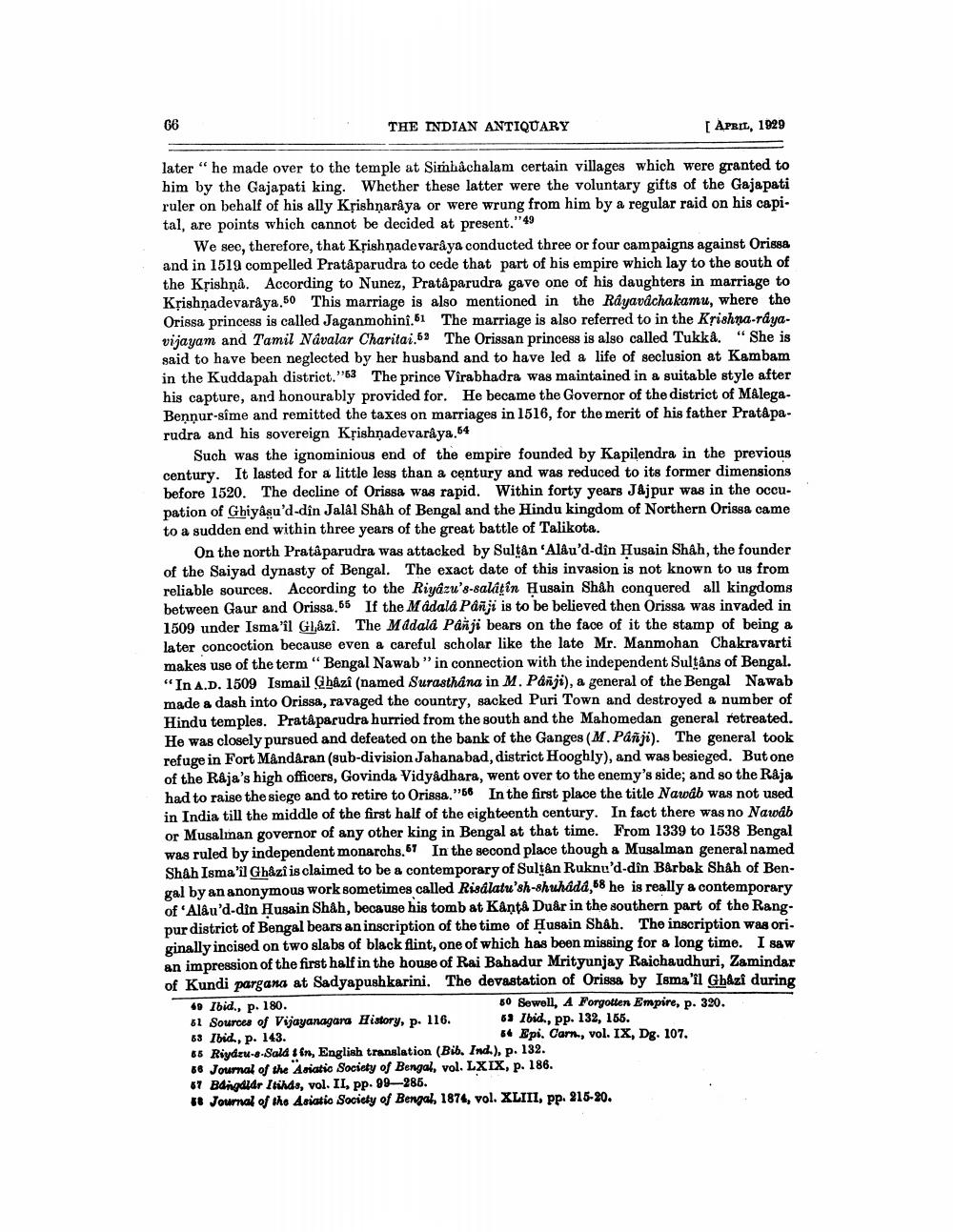________________
66
THE INDIAN ANTIQUARY
[ APRIT, 1929
later" he made over to the temple at Simhachalam certain villages which were granted to him by the Gajapati king. Whether these latter were the voluntary gifts of the Gajapati ruler on behalf of his ally Krishnaraya or were wrung from him by a regular raid on his capital, are points which cannot be decided at present."'49
We see, therefore, that Krishnadevaraya conducted three or four campaigns against Orissa and in 1519 compelled Pratáparudra to cede that part of his empire which lay to the south of the Krishna. According to Nunez, Pratâparudra gave one of his daughters in marriage to Krishnadevaraya,50 This marriage is also mentioned in the Rayavachakamu, where the Orissa princess is called Jaganmohini.61 The marriage is also referred to in the Krishna-rayavijayam and Tamil Navalar Charitai.53 The Orissan princess is also called Tukka. “She is said to have been neglected by her husband and to have led a life of seclusion at Kambam in the Kuddapah district."63 The prince Virabhadra was maintained in a suitable style after his capture, and honourably provided for. He became the Governor of the district of MAlegaBennur-sîme and remitted the taxes on marriages in 1516, for the merit of his father Pratáparudra and his sovereign Krishnadevaraya.54
Such was the ignominious end of the empire founded by Kapilendra in the previous century. It lasted for a little less than a century and was reduced to its former dimensions before 1520. The decline of Orissa was rapid. Within forty years Jajpur was in the occupation of Ghiyâsu'd-dîn Jalal Shah of Bengal and the Hindu kingdom of Northern Orissa came to a sudden end within three years of the great battle of Talikota.
On the north Prataparudra was attacked by Sultan Alau'd-din Husain Shah, the founder of the Saiyad dynasty of Bengal. The exact date of this invasion is not known to us from reliable sources. According to the Riyazu's-salátin Husain Shah conquered all kingdoms between Gaur and Orissa.65 If the Madala Panji is to be believed then Orissa was invaded in 1509 under Isma'il Glazi. The Madala Panji bears on the face of it the stamp of being a later concoction because even a careful scholar like the late Mr. Manmohan Chakravarti makes use of the term “Bengal Nawab "in connection with the independent Sultans of Bengal. “In A.D. 1509 Ismail Ghazi (named Surasthana in M. Panji), a general of the Bengal Nawab made a dash into Orissa, ravaged the country, sacked Puri Town and destroyed a number of Hindu temples. Pratâ parudra hurried from the south and the Mahomedan general retreated. He was closely pursued and defeated on the bank of the Ganges (M. Pañji). The general took refuge in Fort Måndaran (sub-division Jahanabad, district Hooghly), and was besieged. But one of the Raja's high officers, Govinda Vidyadhara, went over to the enemy's side; and so the Raja had to raise the siege and to retire to Orissa.":56 In the first place the title Nawab was not used in India till the middle of the first half of the eighteenth century. In fact there was no Nawab or Musalman governor of any other king in Bengal at that time. From 1339 to 1538 Bengal was ruled by independent monarchs.67 In the second place though a Musalman general named Shah Isma'il Ghazi is claimed to be a contemporary of Sultân Ruknu'd-dîn Bârbak Shah of Bengal by an anonymous work sometimes called Risálatu'sh-Shuhada, 68 he is really a contemporary of Alâu'ddin Husain Shah, because his tomb at Kântâ Duár in the southern part of the Rangpur district of Bengal bears an inscription of the time of Husain Shah. The inscription was originally incised on two slabs of black flint, one of which has been missing for a long time. I saw an impression of the first half in the house of Rai Bahadur Mrityunjay Raichaudhuri, Zamindar of Kundi pargana at Sadyapushkarini. The devastation of Orissa by Isma'il Ghazi during * Ibid., p. 180.
50 Sewell, A Forgotten Empire, p. 320. 61 Sourou of Vijayanagara History, p. 116. 63 Ibid., pp. 132, 165. 63 Ibid., p. 143.
5 Epi, Carn., vol. IX, Dg. 107. 66 Riydeu-s-Sald ifn, English translation (Bib. Ind.), p. 132. 66 Journal of the Asiatic Society of Bengal, vol. LXIX, p. 186. 67 Bangdidr Itinds, vol. II, pp. 99—285. ** Journal of the Asiatic Society of Bengal, 1874, vol. XLIII, pp. 215-20.




